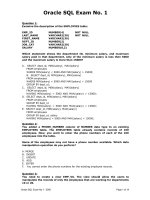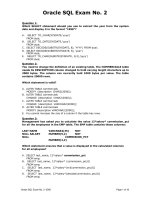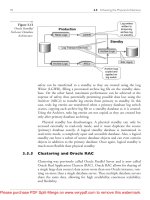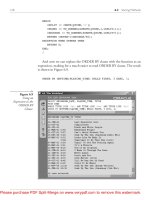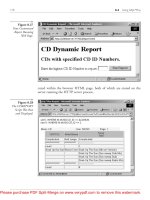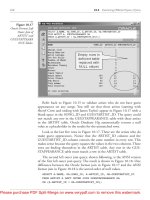Oracle SQL Exam No. 2
Bạn đang xem bản rút gọn của tài liệu. Xem và tải ngay bản đầy đủ của tài liệu tại đây (132.11 KB, 16 trang )
Oracle SQL Exam No. 2
Question 1:
Which SELECT statement should you use to extract the year from the system date
and display it in the format "1998"?
A.
SELECT TO_CHAR(SYSDATE,'yyyy')
FROM dual;
B.
SELECT TO_DATE(SYSDATE,'yyyy')
FROM dual;
C.
SELECT DECODE(SUBSTR(SYSDATE, 8), 'YYYY') FROM dual;
D.
SELECT DECODE(SUBSTR(SYSDATE, 8), 'year')
FROM dual;
E.
SELECT TO_CHAR(SUBSTR(SYSDATE, 8,2),'yyyy')
FROM dual;
Question 2:
You need to change the definition of an existing table. The COMMERCIALS table
needs its DESCRIPTION column
changed to hold varying length characters up to
2000 bytes. The column can currently hold 1000 bytes per value. The table
contains 20000 rows.
Which statement is valid?
A.
ALTER TABLE commercials
MODIFY (description CHAR2(2000));
B.
ALTER TABLE commercials
CHANGE (description CHAR2(2000));
C.
ALTER TABLE commercials
CHANGE (description VARCHAR2(2000));
D.
ALTER TABLE commercials
MODIFY (description VARCHAR2(2000));
E.
You cannot increase the size of a column if the table has rows.
Question 3:
Management has asked you to calculate the value 12*salary* commission_pct for
all the employees in the EMP table. The EMP table contains these columns:
LAST NAME VARCNAR2(35) NOT NULL
SALARY NUMBER(9,2) NOT NULL
COMMISION_PCT NUMBER(4,2)
Which statement ensures that a value is displayed in the calculated columns
for all employees?
A.
SELECT last_name, 12*salary*
commission_pct
FROM emp;
B.
SELECT last_name, 12*salary* (commission_pct,0)
FROM emp;
C.
SELECT last_name, 12*salary*(nvl(commission_pct,0))
FROM emp;
D.
SELECT last_name, 12*salary*(decode(commission_pct,0))
FROM emp;
Question 4:
Oracle SQL Exam No. 2 -2005
Page 1 of 16
The EMPLOYEE tables has these columns:
LAST_NAME VARCHAR2(35)
SALARY NUMBER(8,2)
COMMISSION_PCT NUMBER(5,2)
You want to display the name and annual salary multiplied by the
commission_pct for all employees. For records that have a NULL commission_pct,
a zero must be displayed against the calculated column.
Which SQL statement displays the desired results?
A.
SELECT last_name, (salary * 12) * commission_pct
FROM EMPLOYEES;
B.
SELECT last_name, (salary * 12) * IFNULL(commission_pct, 0)
FROM EMPLOYEES;
C.
SELECT last_name, (salary * 12) * NVL2(commission_pct, 0)
FROM EMPLOYEES;
D.
SELECT last_name, (salary * 12) * NVL(commission_pct, 0)
FROM EMPLOYEES;
Question 5:
Examine the data from the EMP table:
EMP_ID DEPT_ID COMMISSION
1 10 500
2 20 1000
3 10
4 10 600
5 30 800
6 30 200
7 10
8 20 300
The COMMISSION column shows the monthly commission earned by the
employee. Which three tasks would require subqueries or joins in order to
perform in a single step? (Choose three.)
A.
Deleting the records of employees who do not earn commission.
B.
Increasing the commission of employee 3 by the average commission earned in
department 20.
C.
Finding the number of employees who do NOT earn commission and are working for
department 20.
D.
Inserting into the table a new employee 10 who works for department 20 and
earns a commission that is equal to the commission earned by employee 3.
E.
Creating a table called COMMISSION that has the
same structure and data as the
columns EMP_ID and COMMISSIONS of the EMP table.
F.
Decreasing the commission by 150 for the employees who are working in
department 30 and earning a commission of more then 800.
Question 6:
Mary has a view called EMP_DEPT_LOC_VU that was created based on the
EMPLOYEES, DEPARTMENTS, and LOCATIONS tables. She granted SELECT
privilege to Scott on this view.
Oracle SQL Exam No. 2 -2005
Page 2 of 16
Which option enables Scott to eliminate the need to qualify the view with the
name MARY.EMP_DEP_LOC_VU each time the view is referenced?
A.
Scott can create a synonym for the EMP_DEPT_LOC_VU bus using the command:
CREATE PRIVATE SYNONYM EDL_VU
FOR mary.EMP DEPT_LOC_VU;
then he can prefix the columns with this synonymn.
B.
Scott can create a synonym for the EMP_DEPT_LOC_VU by using the command:
CREATE SYNONYM EDL_VU
FOR mary.EMP_DEPT_LOC_VU;
then he can prefix the columns with this synonym.
C.
Scott can create a synonym for the EMP_DEPT_LOC_VU by using the command:
CREATE LOCAL
SYNONYM EDL_VU
FOR mary.EMP DEPT_LOC_VU;
then he can prefix the columns with this synonym.
D.
Scott can create a synonym for the EMP_DEPT_LOC_VU by using the command:
CREATE SYNONYM EDL_VU
ON mary(EMP_DEPT_LOC_VU);
then he can prefix the columns with this synonym.
E.
Scott cannot create a synonym because synonyms can be created only for tables.
F.
Scott cannot create any synonym for Mary’s view. Mary should create a private
synonym for the view and grant SELECT privilege on that synonym to Scott.
Question 7:
Which two are true about aggregate functions? (Choose two.)
A.
You can use aggregate functions in any clause of a SELECT statement.
B.
You can use aggregate functions only in the column list of the SELECT clause and in
the WHERE clause of a SELECT statement.
C.
You can mix single row columns with aggregate functions in the column list of a
SELECT statement by grouping on the single row columns.
D.
You can pass column names, expressions, constants, or functions as parameters to
an aggregate function.
E.
You can use aggregate functions on a table, only by grouping the whole table as one
single group.
F.
You cannot group the rows of a table by more than one column while using
aggregate functions.
Question 8:
Which four statements correctly describe functions that are available in SQL?
(Choose four.)
A.
INSTR returns the numeric position of a named character.
B.
NVL2 returns the first non-null expression in the expression list.
C.
TRUNCATE rounds the column, expression, or value to n decimal places. D.
DECODE translates an expression after comparing it to each search value.
E.
TRIM trims the heading of trailing characters (or both) from a character string. F.
NVL compares two expressions and returns null if they are equal, or the first
expression of they are not equal.
G.
NULLIF compares twp expressions and returns null if they are equal, or the first
expression if they are not equal.
Question 9:
Which three statements correctly describe the functions and use of constraints?
(Choose three.)
A.
Constraints provide data independence. B.
Oracle SQL Exam No. 2 -2005
Page 3 of 16
Constraints make complex queries easy.
C.
Constraints enforce rules at the view level. D.
Constraints enforce rules at the table level.
E.
Constraints prevent the deletion of a table if there are dependencies. F.
Constraints prevent the deletion of an index if there are dependencies.
Question 10:
Examine the data in the EMPLOYEES table.
EMPLOYEE_ID EMP_NAME DEPT_ID MGR_ID JOB_ID SALARY
101 Smith 20 120 SA_REP 4000
102 Martin 10 105 CLERK 2500
103 Chris 20 120 IT_ADMIN 4200
104 John 30 108 HR_CLERK 2500
105 Diana 30 108 HR_MGR 5000
106 Smith 40 110 AD_ASST 3000
108 Jennifer 30 110 HR_DIR 6500
110 Bob 40 EX_DIR 8000
120 Ravi 20 110 SA_DIR 6500
On the EMPLOYEES table, EMPLOYEE_ID is the primary key. MGR_ID is the ID of
managers and refers to the EMPLOYEE_ID. The JOB_ID column is a NOT NULL
column.
Evaluate this DELETE statement:
DELETE employee_id, salary, job_id
FROM employees
WHERE dept_id = 90;
Why does the DELETE statement fail when you execute it?
A.
There is no row with dept_id 90 in the EMPLOYEES table.
B.
You cannot delete the JOB_ID column because it is a NOT NULL column.
C.
You cannot specify column names in the DELETE clause of the DELETE statement.
D.
You cannot delete the EMPLOYEE_ID column because it is the primary key of the
table.
Question 11:
From SQL*Plus, you issue this SELECT statement:
SELECT*
From orders;
You use this statement to retrieve data from a data table for __________.
(Choose all that apply.)
A.
Updating
B.
Viewing
C.
Deleting
D.
Inserting
E.
Truncating
Question 12:
Oracle SQL Exam No. 2 -2005
Page 4 of 16
You define a multiple-row subquery in the WHERE clause of an SQL query with
a comparison operator "=".
What happens when the main query is executed?
A.
The main query executes with the first value returned by the subquery. B.
The main query executes with the last value returned by the subquery. C.
The
main query executes with all the values returned by the subquery.
D.
The main query fails because the multiple-row subquery cannot be used with the
comparison operator.
E.
You cannot define a multiple-row subquery in the WHERE clause of a SQL query.
Question 13:
Scott issues the SQL statements:
CREATE TABLE dept
(deptno NUMBER(2),
dname VARCHAR2(14),
loc VARCHAR2(13)};
GRANT SELECT
ON DEPT
TO SUE;
If Sue needs to select from Scott's DEPT table, which command should she use?
A.
SELECT *
FROM DEPT;
B.
SELECT *
FROM SCOTT.DEPT;
C.
SELECT *
FROM DBA.SCOTT.DEPT;
D.
SELECT *
FROM ALL_USERS
WHERE USER_NAME = 'SCOTT'
AND TABLE NAME = 'DEPT';
Question 14:
Examine the data of the EMPLOYEES table.
EMPLOYEES (EMPLOYEE_ID is the primary key. MGR_ID is the ID of managers
and refers to the EMPLOYEE_ID)
EMPLOYEE_ID EMP_NAME DEPT_ID MGR_ID JOB_ID SALARY
101 Smith 20 120 SA_REP 4000
102 Martin 10 105 CLERK 2500
103 Chris 20 120 IT_ADMIN 4200
104 John 30 108 HR_CLERK 2500
105 Diana 30 108 HR_MGR 5000
106 Bryan 40 110 AD_ASST 3000
108 Jennifer 30 110 HR_DIR 6500
110 Bob 40 EX_DIR 8000
120 Ravi 20 110 SA_DIR 6500
Which statement lists the ID, name, and salary of the employee, and the ID and
Oracle SQL Exam No. 2 -2005
Page 5 of 16
name of the employee's manager, for all the employees who have a manager and
earn more than 4000?
A.
SELECT employee_id "Emp_id", emp_name "Employee", salary,
employee_id "Mgr_id", emp_name "Manager"
FROM employees
WHERE salary > 4000;
B.
SELECT e.employee_id "Emp_id", e.emp_name "Employee", e.salary,
m.employee_id "Mgr_id", m.emp_name "Manager"
FROM employees e, employees m
WHERE e.mgr_id = m.mgr_id
AND e.salary > 4000;
C.
SELECT e.employee_id "Emp_id", e.emp_name "Employee", e.salary,
m.employee_id "Mgr_id", m.emp_name "Manager"
FROM employees e, employees m
WHERE e.mgr_id = m.employee_id
AND e.salary > 4000;
D.
SELECT e.employee_id "Emp_id", e.emp_name "Employee", e.salary,
m.mgr_id "Mgr_id", m.emp_name "manager"
FROM employees e, employees m
WHERE e.mgr_id = m.employee_id
AND e.salary > 4000;
E.
SELECT e.employee_id "Emp_id", e.emp_name "Employee", e.salary,
m.mgr_id "Mgr_id", m.emp_name "Manager"
FROM employees e, employees m WHERE
e.employee_id = m.employee_id AND
e.salary > 4000;
Question 15:
The ORDERS table has these columns:
ORDER_ID NUMBER(4) NOT NULL
CUSTOMER_ID NUMBER(12) NOT NULL
ORDER_TOTAL NUMBER(10,2)
The ORDERS table tracks the Order number, the order total, and the customer to
whom the Order belongs. Which two statements retrieve orders with an inclusive
total that ranges between 100.00 and 2000.00 dollars? (Choose two.)
A.
SELECT customer_id, order_id, order_total
FROM orders
RANGE ON order_total (100 AND 2000) INCLUSIVE;
B.
SELECT customer_id, order_id, order_total
FROM orders
HAVING order_total BETWEEN 100 and 2000;
C.
SELECT customer_id, order_id, order_total
FROM orders
WHERE order_total BETWEEN 100 and 2000;
D.
SELECT customer_id, order_id, order_total
FROM orders
WHERE order_total >= 100 and <= 2000; E.
SELECT customer_id, order_id, order_total
FROM orders
WHERE order_total >= 100 and order_total <= 2000;
Question 16:
Examine the data of the EMPLOYEES table.
Oracle SQL Exam No. 2 -2005
Page 6 of 16
